
When most people think of pet birds, they picture high-maintenance parrots that require hours of daily care.
However, there are actually a number of low-maintenance pet bird species that make great companions for busy bird enthusiasts.
If you’re considering adding a feathered friend to your family, here are a few low-maintenance bird breeds to look into.
What Makes “Low Maintenance” Pet Birds?
There are a variety of bird species that are suitable for those who do not have a lot of time to dedicate to their feathered friends.
Let’s explore what makes a bird species low maintenance so that you can make an informed decision when choosing your next pet.
Size Matters
One of the first things to consider when choosing a low-maintenance bird is its size.
Smaller birds require less food and produce less waste, which means that there is less cleaning up for you to do.
Budgies, canaries, and finches are all good examples of small birds that are relatively low-maintenance.
If you’re looking for something a little bigger, cockatiels and conures are also great options.
Minimal Grooming Needs
Another thing to consider is how much grooming the bird will need.
Birds that do not need to be bathed or have their feathers trimmed on a regular basis are typically easier to care for.
Some birds, like lovebirds, are known for being particularly messy and requiring frequent baths.
Others, like cockatiels, only need occasional baths and do not need their feathers trimmed.
Consider Your Lifestyle
Finally, it is important to take your own lifestyle into consideration when choosing a low-maintenance bird.
If you travel often or have a busy work schedule, you will want to choose a bird that is okay with being left alone for long periods of time.
Birds that require more attention and interaction may become agitated if they are left alone too often and may start to exhibit undesirable behaviors, such as screeching or feather-plucking.
Birds like parakeets and cockatiels typically do well with people who have busy lifestyles since they are content with playing by themselves and only require minimal interaction.
What is the Easiest Pet Bird to Take Care Of?
Considering a pet bird but not sure which one is best for you?
Below, we’ll explore the top three easiest pet birds to take care of so that you can make an informed decision.
From the dove to the parakeet, there’s bound to be a birdie out there that’s perfect for you and your lifestyle. Let’s get started!
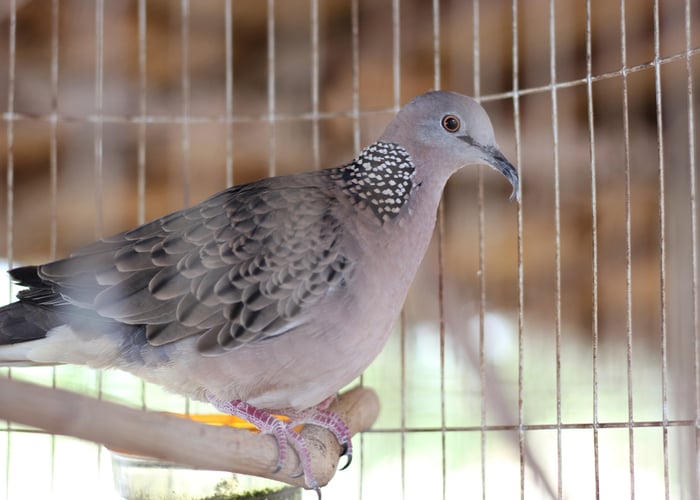
1. Dove
If you’re looking for a pet bird that is low-maintenance and doesn’t require a lot of care, then a dove may be the perfect choice for you!
Doves are gentle creatures that are very easy to care for, and they make great companions.
One of the great things about doves is that they don’t need a lot of space to feel comfortable and happy.
A small cage or aviary is all they need, which makes them ideal pets for people who live in apartments or small homes.
If you’re looking for a pet bird that won’t make too much noise, then a dove is a good option.
They cool softly instead of squawking loudly, so they won’t disturb your neighbors or family members.
Doves enjoy being around people and other birds, so they make excellent companions.
They will bond with their owner and may even perch on your shoulder!
Finally, doves don’t require a lot of care or attention, which makes them ideal pets for busy people.
They are also very resilient birds and can tolerate changes in their environment fairly well.

2. Lineolated Parakeet
The Lineolated Parakeet is one of the best kinds of pet birds for first-time owners. Here’s why:
Lineolated Parakeets are easy to care for and don’t require a lot of time or attention.
This makes them ideal for first-time bird owners who may not be sure if they are ready to commit to a high-maintenance pet like a macaw or cockatoo.
One of the main reasons people choose Lineolated Parakeets as their pets is because they are relatively quiet compared to other kinds of birds.
If you live in an apartment or close quarters, this may be especially important to you.
You won’t have to worry about your Lineolated Parakeet waking you up at the crack of dawn with their loud squawking.
Finally, Lineolated Parakeets are very social creatures and enjoy being around people.
This makes them great pets for families with kids or anyone who wants a pet that will be interactive and fun to be around.
While they do enjoy human interaction, they also do well on their own if you need to leave them alone for short periods of time.
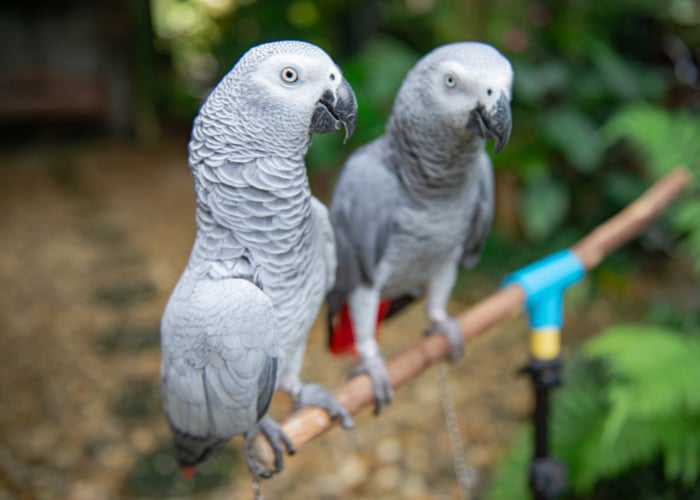
3. Gabon Gray Parrot
If you’re thinking of getting a pet bird, you might want to consider a Gabon gray parrot.
These beautiful birds make great companions and are relatively low maintenance compared to other pet bird species.
Native to the rainforests of central Africa, Gabon gray parrots are one of the largest species of African parrots.
They have striking gray plumage and can live for up to 50 years in captivity!
When choosing a Gabon gray parrot as a pet, it’s important to find a reputable breeder who can provide you with a healthy, well-socialized bird.
Gabon gray parrots require a diet of fresh fruits and vegetables, as well as quality pellet food.
Be sure to also include some toys and perches in their enclosure so they can exercise and play.
It’s also important to give them plenty of time out of their cage each day to stretch their wings and explore.
When it comes to care, Gabon gray parrots are relatively low maintenance compared to other pet bird species.
They are not known for being particularly messy, so you won’t have to deal with too much cleaning up after them!
Gabon gray parrots are intelligent birds and can be trained to do tricks or speak words and phrases.
However, they are also known for being rather loud, so if you’re looking for a low-noise pet bird, this may not be the species for you.
Additionally, Gabon gray parrots are social creatures and do best when they have another bird companion.
They can bond very closely with their human caregivers too, so be prepared to spend lots of time interacting with your new feathered friend!

4. Canary
Of all the pet birds you can own, canaries are often considered to be some of the best options for low-maintenance bird ownership.
Canaries are small in size, require minimal amounts of equipment, and are relatively easy to care for.
One of the biggest benefits of owning a canary is that they don’t require a lot of space.
Canaries are content to stay in smaller cages or aviaries, as long as they have enough room to flit about and stretch their wings.
This makes them ideal pets for people who live in small apartments or houses.
Another plus side of canaries is that they don’t need a lot of food or water.
A small bowl of fresh water and a cup or two of birdseed per day is all they’ll need to stay healthy and happy.
This makes them much easier to care for than larger birds, who often require special diets and more frequent feedings.
In general, canaries are relatively easy to care for.
They don’t need regular baths as some other birds do, and their simple diet means there’s no need for elaborate food preparation.
As long as you keep their cage clean and provide them with fresh food and water on a daily basis, your canary will be happy and healthy.
If you’re looking for a pet bird that won’t drive you crazy with squawking, canaries are a good option.
These little birds are relatively quiet, and only sing when they’re happy and comfortable in their surroundings.
This makes them ideal pets for people who live in close quarters with others, such as in apartments or condos.

5. Pionus Parrot
Pionus parrots are relatively small birds, which means they don’t require a lot of space.
A Pionus parrot can live happily in a cage that’s just two feet by two feet by four feet. That makes them ideal pet birds for people who live in small apartments or houses.
Pionus parrots are also very quiet birds. They don’t have the loud screeches that some other species of pet birds are known for.
That means they’re less likely to disturb your neighbors or cause a ruckus in your home.
If you’re looking for a pet bird that won’t make too much noise, a Pionus parrot is a good choice.
Pionus parrots are also relatively low-maintenance when it comes to their diet.
These birds are native to Central and South America, and in the wild, they eat a diet of fruit, vegetables, and seeds. You can duplicate this diet fairly easily with store-bought bird food mixes meant for parrots.
You’ll also want to offer your Pionus parrot fresh fruits and vegetables as part of its diet to ensure it gets the nutrients it needs.

6. Zebra Finch
If you’re looking for a low-maintenance pet bird, you can’t go wrong with a zebra finch.
Zebra finches are relatively small birds that are easy to care for and don’t require a lot of space.
They are also social creatures that enjoy the company of their owners and make great companions.
One of the reasons why zebra finches make great low-maintenance pet birds is because they are relatively small birds that don’t require a lot of space.
A typical zebra finch cage should be at least 18 inches long, 18 inches wide, and 24 inches tall.
These dimensions will give your finch plenty of room to fly and exercise.
When it comes to food, zebra finches are not picky eaters and will eat a variety of different foods.
A good diet for a zebra finch includes a mix of seeds, pellets, vegetables, and fruits. You can also supplement your finch’s diet with live foods such as mealworms or crickets.
Another reason why zebra finches make great pets is that they are social creatures that enjoy the company of their owners.
Zebra finches are known to be very curious birds and will often approach their owners when they enter the room.
These friendly little birds also love to perch on their owner’s shoulder or hand and will even follow them around the house.
Because zebra finches enjoy the company of their owners so much, it’s important to spend time interacting with them on a daily basis.
Taking your zebra finch out of its cage for some one-on-one time is essential to keeping your bird happy and healthy.
During your playtime, you can offer your bird some toys to play with or simply let it explore its surroundings.

7. Religious Mynah
Compared to other pet birds, religious mynahs have very minimal care requirements.
They are perfectly content living in a small cage as long as they have access to food, water, and some toys to keep them entertained.
You won’t need to spend hours every day cleaning their cage or preparing special meals—a quick once-over with a broom will suffice.
Another reason why religious mynahs are such low-maintenance pets is that they aren’t picky eaters.
A simple diet of seeds, fruits, and vegetables is all they need to stay healthy and happy.
You won’t need to spend time cooking up elaborate meals or worrying about whether or not they’re getting the right nutrients.
Religious mynahs are also known for being independent creatures that don’t require much attention from their owners.
They are perfectly content sitting in their cage while you go about your day-to-day activities.
You won’t need to set aside time each day to play with them or take them out for walks—a quick head scratch now and then will suffice.
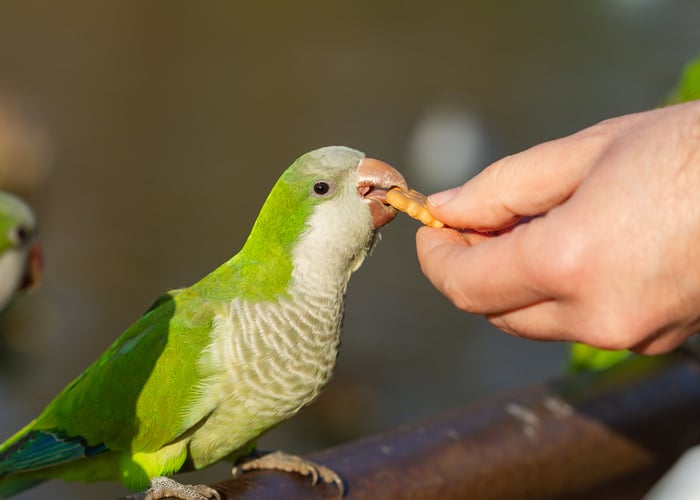
8. Quaker Parrot
Quaker parrots originate from South America, specifically from countries like Argentina, Brazil, and Uruguay.
Also known as Monk parakeets or Colonial parakeets, these birds got their nickname “Quaker” because of their habit of bobbing their heads up and down—which looks a lot like praying!
Quaker parrots are relatively small compared to other parrots, with an average length of about 11 inches.
They are also one of the more affordable pet birds, with prices ranging anywhere from $50-$200.
Other than basic daily care, Quaker parrots are very low-maintenance pets.
They are known for being quiet (unlike some other kinds of pet birds), and they don’t require as much attention as some of the bigger birds.
If you work long hours or travel often, a Quaker parrot may be a good fit for you.
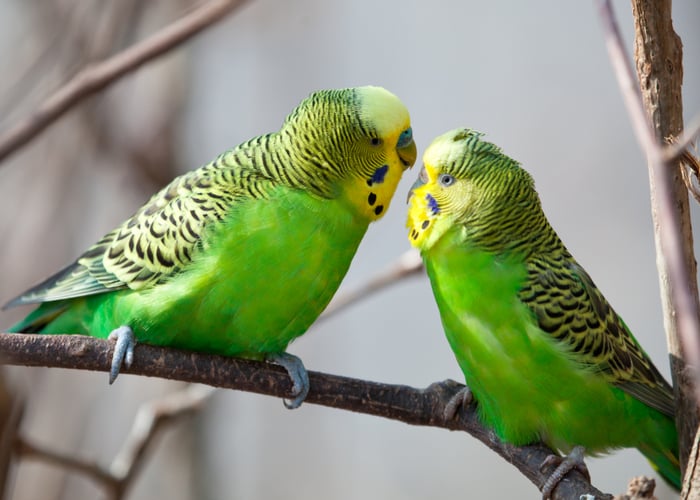
9. Budgies
One of the reasons why budgies are such popular pets is that they don’t need a lot of space to live comfortably.
A small cage—around 18″ x 18″ x 18″—is more than enough room for your budgie to fly around and play.
Just make sure that the bar spacing on the cage is no more than 1/2″ so that your budgie doesn’t escape!
Budgies are also low maintenance when it comes to grooming.
They don’t need to be bathed like some other birds (although they do enjoy taking a mist bath from time to time) and their feathers will stay clean with regular dusting.
And because they’re such small birds, they don’t produce as much waste as larger birds, which means cleaning their cage isn’t as big of a chore.
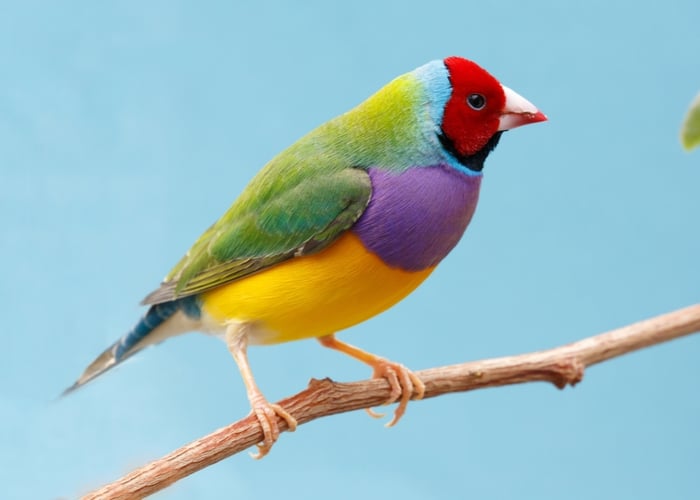
10. Gould’s Diamond
If you’re considering getting a pet bird, you might want to consider the Gould’s Diamond.
These little guys are known for being low maintenance, loving, and relatively quiet—perfect for those who live in apartments or small spaces.
One of the best things about Gould’s Diamonds is that they don’t require a lot of care.
They’re relatively self-sufficient and can be entertained with just a few toys. This makes them perfect for busy people or those who might not have a lot of experience caring for birds.
Gould’s diamonds are known for being affectionate birds that enjoy human interaction.
They make great pets for families with small children or those who are looking for an animal companion.
If you live in an apartment or somewhere where noise might be an issue, then a Gould’s Diamond is a great option.
These birds are relatively quiet and won’t disturb your neighbors.
With proper care, Gould’s diamonds can live between 10-12 years, which is much longer than other small pets such as hamsters or gerbils.
So if you’re looking for a pet that will be around for a while, then this might be the one for you!
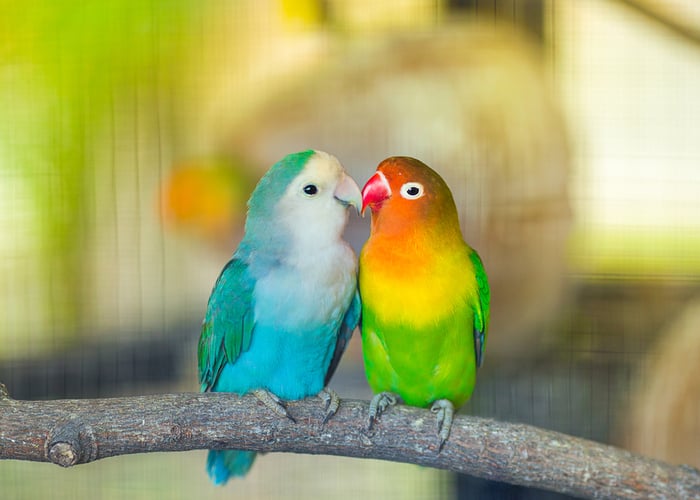
11. Lovebird
One of the main reasons lovebirds are considered low maintenance is that they have shorter lifespans than most other pet birds.
Where a parrot can live 50 years or more, lovebirds typically only live between 10 and 15 years.
This means that they don’t require as much long-term care as some other pet bird options.
Another reason lovebirds are low maintenance is that they’re smaller birds. This means they don’t require as large of a cage as some other types of pet birds.
They also don’t produce as much waste, so there’s less cleaning required to keep their living area clean and tidy.
And because they’re small, they don’t have as much power to destroy things in your home when they get bored or frustrated—something that can happen with larger birds like parrots.
Many birds require social interaction and need to be around other birds or people to stay healthy and happy.
Lovebirds, on the other hand, are perfectly content being alone and don’t mind spending time solo in their cage.
This makes them a good choice for busy people who might not have the time to provide the constant attention that some other types of pet birds need.
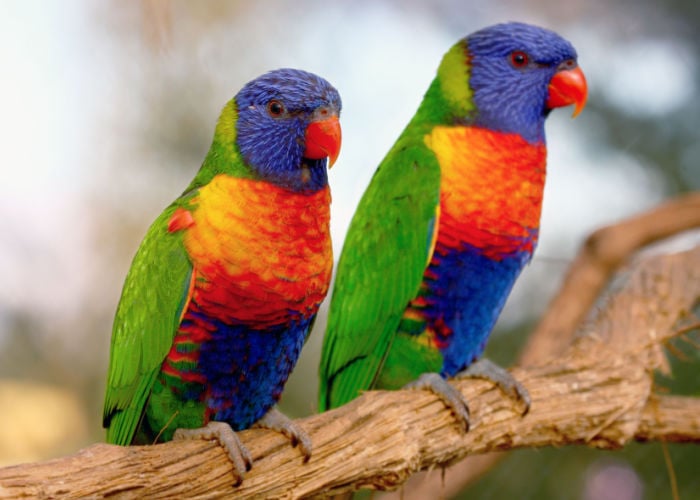
12. Lori
One of the benefits of owning a Lori is that they are relatively low-maintenance birds.
They do not require a lot of space, and they can be easily trained to use a litter box.
Loris are also known for being quiet birds, so if you’re looking for a pet bird that won’t make too much noise, a Lori might be a good choice.
Another benefit of owning a Lori is that they are relatively long-lived birds. With proper care, a Lori can live for 10-15 years.
This makes them a great choice for someone who is looking for a long-term commitment.
Finally, Loris are known for being affectionate birds. They enjoy spending time with their human companions and can even be taught to perform simple tricks.
If you’re looking for a cuddly and affectionate pet bird, a Lori might be the perfect choice for you.

13. Cockatiel
Cockatiels are low maintenance compared to other pet birds because they do not require as much space or attention.
They are content to perch on their owner’s shoulder or sit in their cage, and they do not need to fly around to stay happy and healthy.
This makes them a good choice for people who live in small apartments or who travel often.
Cockatiels are very social creatures and love to interact with their owners.
They can learn to mimic human speech and sounds, which makes them fun and entertaining pets.
Cockatiels are also relatively easy to train to do tricks, such as flying to your hand or stepping up onto your finger.
This means that they make great pets for both children and adults alike.
Cockatiels are one of the most inexpensive pet birds you can buy.
Their food is relatively cheap, and they do not require a lot of toys or equipment like some other bird species do.
This makes cockatiels a great choice for low-maintenance pet birds and budget-conscious pet owners.

14. Parrotlet
A parrotlet is a small species of parrot that is native to Central and South America.
There are several different species of parrotlets, but the most common in captivity is the Pacific parrotlet (Forpus coelestis).
Pacific parrotlets are about five inches long and weigh about two ounces.
They have bright green plumage with yellowish markings on their wings. Males and females look similar, but males usually have brighter colors.





